To help pay its massive debts from the Seven Years’ War, the British Parliament – at the advice of Charles Townshend, the Chancellor of the British Exchequer – voted to levy new taxes on the American colonies.
The Seven Years’ War had involved virtually every great power of Europe and spanned the entire globe. While it ended French influence in North America east of the Mississippi River, the war also left the British monarchy facing massive debt.
Since parts of the war had been fought in North America (known as the French and Indian War), and British forces had protected the American Colonies from attack, the British Crown expected the colonists to pay a share of the debt.
Britain also needed additional revenue to fund the administration of its growing efforts toward global imperialism. Before the French and Indian War, the British government had been hesitant to tax its American Colonies. (Longley)
The Townshend Acts (June 15–July 2, 1767) were a series of four acts passed by the British Parliament in an attempt to assert what it considered to be its historic right to exert authority over the colonies through suspension of a recalcitrant representative assembly and through strict provisions for the collection of revenue duties.
They bear the name of Charles Townshend, Chancellor of the Exchequer, who is – as the chief treasurer of the British Empire – in charge of economic and financial matters and who sponsored them.
- The Suspending Act (New York Restraining Act) (June 5, 1767) banned the New York Colony Assembly from conducting business until it agreed to pay for the housing, meals, and other expenses of British troops stationed there under the Quartering Act of 1765.
- The Revenue Act (Townshend duties) (June 26, 1767) imposed direct revenue duties – that is, duties aimed not merely at regulating trade but at putting money into the British treasury. These were payable at colonial ports and fell on tea, wine, lead, glass, paper, and paint imported into the colonies. Since Britain held a monopoly on these products, the colonies could not legally buy them from any other country. It was the second time in the history of the colonies that a tax had been levied solely for the purpose of raising revenue.
- The Commissioners of Customs Act (June 29, 1767) established an American Customs Board. Headquartered in Boston, the five British-appointed commissioners of the Customs Board enforced a strict and often arbitrarily applied set of shipping and trade regulations (including additional officers, searchers, spies, coast guard vessels, search warrants, writs of assistance), all intended to increase taxes paid to Britain.
- The Indemnity Act (June 29, 1767) was aimed at enabling the East India Company to compete with the tea that was smuggled by the Dutch. It lowered commercial duties on tea imported to England by the East India Company and gave the company a refund of the duty for tea that was then exported to the colonies. Compensating for the loss of revenue brought about by the Indemnity Act was another reason for the imposition of the Townshend duties.
The acts renewed a fierce debate over whether the British Parliament had the right to tax the North American colonies solely for the purpose of raising revenue.
The colonists protested, “no taxation without representation,” arguing that the British Parliament did not have the right to tax them because they lacked representation in the legislative body. They asserted that only colonial assemblies elected by themselves should have the power to impose taxes. (Khan Academy)
The most influential colonial objection to the Townshend Acts came in twelve essays by John Dickinson entitled “Letters from a Farmer in Pennsylvania.” Published starting in December 1767, Dickinson’s essays urged colonists to resist paying the British taxes.
Moved by the essays, James Otis of Massachusetts rallied the Massachusetts House of Representatives, along with other colonial assemblies, to send petitions to King George III demanding repeal of the Revenue Act.
Colonists organized boycotts of British goods to pressure Parliament to repeal the Townshend Acts. As British customs officials arrived to collect taxes and prosecute smugglers, colonial opposition intensified, resulting in street demonstrations and protests that sometimes turned violent.
The presence of British troops in Boston was a standing invitation to disorder. On March 5, 1770, antagonism between citizens and British soldiers again flared into violence. What began as a harmless snowballing of British soldiers degenerated into a mob attack. Someone gave the order to fire; this was the ‘Boston Massacre.’
Faced with such opposition, Parliament in 1770 opted for a strategic retreat and repealed all the Townshend duties except that on tea, which was a luxury item in the colonies, imbibed only by a very small minority.
To most, the action of Parliament signified that the colonists had won a major concession, and the campaign against England was largely dropped. A colonial embargo on ‘English tea’ continued but was not too scrupulously observed. Prosperity was increasing and most colonial leaders were willing to let the future take care of itself. (University of Groningen)
Click the following link to a general summary about the Townshend Acts:





























